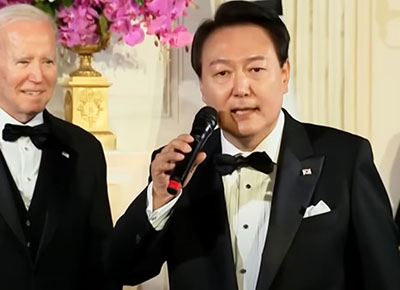Special to WorldTribune.com
 By John J. Metzler, April 28, 2023
By John J. Metzler, April 28, 2023
Seventy years is a long time, especially for a military alliance even between friends. There are few in the world, notably including the Atlantic Alliance, forming NATO in 1949.
But in the case of East Asia, the strategic and economic links which emerged from the cauldron of the Korean War ending in 1953, created an extraordinary success story recently celebrated by South Korean President Yoon Suk-Yeol’s state visit to Washington D. C.
Addressing a joint session of the U.S. Congress, [see video below] President Yoon received a rousing reception from American lawmakers, during which he lauded the U.S./South Korea alliance as a “linchpin” in safeguarding freedom. Yoon honored U.S. troops who served in the Korean War, noting that tens of thousands of them died to defend the freedom of his country across the Pacific.
President Yoon stated poignantly, “Sons and daughters of America sacrificed their lives to defend a country they never knew and a people they never met”.

He outlined South Korea’s aspirations to become a “global pivotal state.” During the summit both Presidents Joe Biden and Yoon pledged to deepen extended deterrence in response to North Korea’s growing nuclear threat as well as enhance intelligence sharing and cybersecurity.
Yoon underscored the Seoul government’s commitment to democracy, deterrence and digital innovation.
Today most people view modern Korea, as that of Hallyu, Hyundai, Samsung and BTS.
This is the contemporary image. Yet the success story that is South Korea has been around for decades now emerged from the post war narrative where a relatively small, devastated and divided Korean Peninsula was growing from the devastating 1950-1953 war.
U.S./South Korean two-way trade reached $187 billion in 2022, that’s up from $101 billion in 2012. Significantly though, China is South Korea’s major trading partner for over a decade.
Economists tell us that South Korea, the free and vibrant part of the divided nation, grew like the Phoenix in the 1960’s and 1970’s through hard work and perseverance. But until Seoul hosted the 1988 Summer Olympics, the saga was still very much before and after.
The before was a rebuilding Korea, controlled by a rigid authoritarian political system run by former generals in civilian clothes. Then came the democratic surge on the cusp of the Summer Games which led to a fractious but vibrant democracy since the late 1980’s to this day.
|
“Sons and daughters of America sacrificed their lives to defend a country they never knew and a people they never met” |
The underlying reason of the ROK/U.S. military treaty was obviously defense, but more specifically, deterrence; Avoiding a war with the bellicose Democratic People’s Republic of Korea (DPRK), aka the communist North. Equally the Treaty offered the ultimate insurance policy for South Korea that it could build and prosper in safety behind the U.S. defense shield despite the shadows from the North.
The Military treaty stems from an arc of interlocking system of defense pacts implemented during the Eisenhower Administration; Korea 1953, ROC/Taiwan 1954, and Japan 1960. The U.S./ROK Mutual Defense Treaty was framed by the able American Secretary of State John Foster Dulles.
Viewing the military equation, American forces are still stationed along the Demilitarized Zone (DMZ) on the 38th parallel separating the two sides. The U.S. forces, now numbering only 28,500 serve as a military trip wire to forestall any rash moves by the North.
Nonetheless, North Korea’s rogue nuclear weapons and missile programs since the 1990’s have dramatically changed the military calculus.
President Yoon, a conservative elected last year, drew a sharp contrast between South Korea and North Korea, warning that “North Korea’s nuclear program and missile provocations pose a serious threat to the peace on the Korean Peninsula and beyond.”
DPRK missile firings and past nuclear tests have formed the cornerstone of Kim Jong-Un’s regime; This year alone the North has fired 3 ICBM’s and 14 other ballistic missiles into the sea and usually off Japan. The warnings are clear.
The UN Security Council regularly meets to discuss North Korean proliferation, and then nervously waits for the next incident. This is not a sustainable policy. What if one such firing were not a test or mistakenly hit a commercial airliner? Is this an accident waiting to happen?
The ROK/U.S. Alliance is built around deterrence and trust, two vital components maintaining security in East Asia. Moreover, on the divided peninsula, South Korea has clearly won the battle of ideas, political democracy, economic prosperity and scientific innovation.
Yoon stated proudly, “Together with the U.S., Korea will play the role as a compass for freedom.”
John J. Metzler is a United Nations correspondent covering diplomatic and defense issues. He is the author of Divided Dynamism the Diplomacy of Separated Nations: Germany, Korea, China (2014). [See pre-2011 Archives]
Membership . . . . Intelligence . . . . Publish
